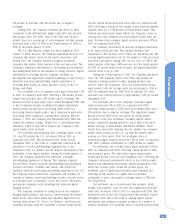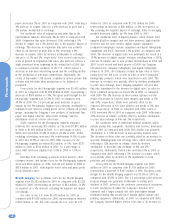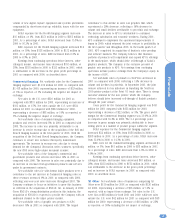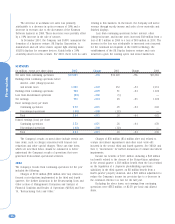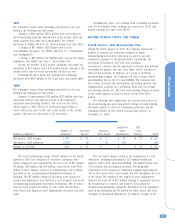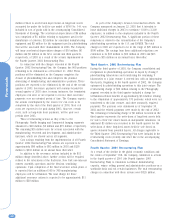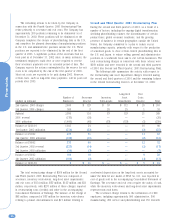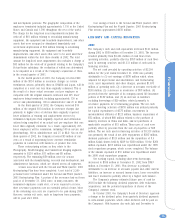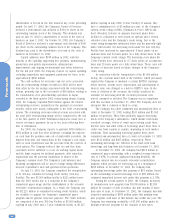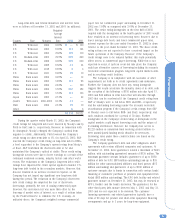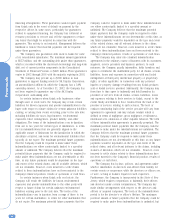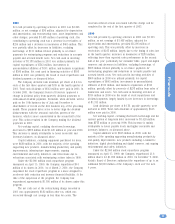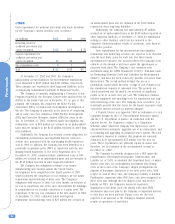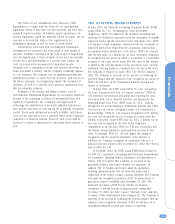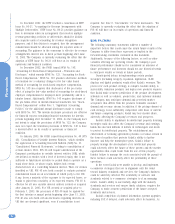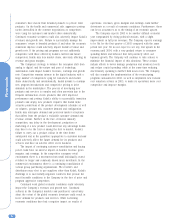Kodak 2002 Annual Report Download - page 27
Download and view the complete annual report
Please find page 27 of the 2002 Kodak annual report below. You can navigate through the pages in the report by either clicking on the pages listed below, or by using the keyword search tool below to find specific information within the annual report.
Financials
27
Long-term debt and related maturities and interest rates
were as follows at December 31, 2002 and 2001 (in millions):
Weighted-
Average
Interest
Country Type Maturity Rate 2002 2001
U.S. Term note 2002 6.38% $ — $ 150
U.S. Term note 2003 9.38% 144 144
U.S. Term note 2003 7.36% 110 110
U.S. Medium-term 2005 7.25% 200 200
U.S. Medium-term 2006 6.38% 500 500
U.S. Term note 2008 9.50% 34 34
U.S. Term note 2018 9.95% 3 3
U.S. Term note 2021 9.20% 10 10
China Bank Loans 2002 6.28% — 12
China Bank Loans 2003 5.49% 114 96
China Bank Loans 2004 2.42% — 190
China Bank Loans 2004 5.58% 252 182
China Bank Loans 2005 5.53% 124 133
Japan Bank Loans 2003 2.51% — 42
Qualex Term notes 2003-2005 6.12% 44 —
Chile Bank Loans 2004 2.61% 10 10
Other 66
$1,551 $1,822
During the quarter ended March 31, 2002, the Company’s
credit ratings for long-term debt were lowered by Moody’s and by
Fitch to Baa1 and A-, respectively. However, in connection with
its downgrade, Moody’s changed the Company’s outlook from
negative to stable. Additionally, Fitch lowered the Company’s
credit rating on short-term debt to F2. On April 23, 2002, S&P
lowered the Company’s credit rating on long-term debt to BBB+,
a level equivalent to the Company’s current rating from Moody’s
of Baa1. S&P reaffirmed the short-term debt at A2 and
maintained the Company’s outlook at stable. These credit rating
downgrade actions were due to lower earnings as a result of the
continued weakened economy, industry factors and other world
events. The reductions in the Company’s long-term debt credit
ratings have impacted the credit spread applied to Kodak’s U.S.
long-term debt traded in the secondary markets. However, this
has not resulted in an increase in interest expense, as the
Company has not issued any significant new long-term debt
during this period. The reduction in the Company’s short-term
debt credit ratings has impacted the cost of short-term
borrowings, primarily the cost of issuing commercial paper.
However, this increased cost was more than offset by the
lowering of market rates of interest as a result of actions taken
by the Federal Reserve to stimulate the U.S. economy. As
indicated above, the Company’s weighted average commercial
paper rate for commercial paper outstanding at December 31,
2002 was 1.97% as compared with 3.61% at December 31,
2001. The credit rating downgrades in the first half of 2002
coupled with the downgrades in the fourth quarter of 2001 would
have resulted in an increase in borrowing rates; however, due to
lower average debt levels and lower commercial paper rates,
interest expense for the year ended December 31, 2002 is down
relative to the year ended December 31, 2001. The above credit
rating actions are not expected to have a material impact on the
future operations of the Company. However, if the Company’s
credit ratings were to be reduced further, this could potentially
affect access to commercial paper borrowing. While this is not
expected to occur, if such an event did take place the Company
could use alternative sources of borrowing including its accounts
receivable securitization program, long-term capital markets debt,
and its revolving credit facilities.
The Company is in compliance with all covenants or other
requirements set forth in its credit agreements and indentures.
Further, the Company does not have any rating downgrade
triggers that would accelerate the maturity dates of its debt, with
the exception of the following: a $110 million note due April 15,
2003 and $44 million in term notes that will amortize through
2005 that can be accelerated if the Company’s credit rating from
S&P or Moody’s were to fall below BBB and BBB-, respectively;
and the outstanding borrowings under the accounts receivable
securitization program if the Company’s credit ratings from S&P
or Moody’s were to fall below BBB- and Baa3, respectively, and
such condition continued for a period of 30 days. Further
downgrades in the Company’s credit rating or disruptions in the
capital markets could impact borrowing costs and the nature of
its funding alternatives. However, the Company has access to
$2,225 million in committed bank revolving credit facilities to
meet unanticipated funding needs should it be necessary.
Borrowing rates under these credit facilities are based on the
Company’s credit rating.
The Company guarantees debt and other obligations under
agreements with certain affiliated companies and customers. At
December 31, 2002, these guarantees totaled a maximum of $345
million, with outstanding guaranteed amounts of $159 million. The
maximum guarantee amount includes: guarantees of up to $160
million of debt for KPG ($74 million outstanding) and up to $19
million for other unconsolidated affiliates and third parties ($17
million outstanding) and guarantees of up to $166 million of
customer amounts due to banks in connection with various banks’
financing of customers’ purchase of products and equipment from
Kodak ($68 million outstanding). The KPG debt facility and related
guarantee mature on December 31, 2005, but may be renewed at
KPG’s, Kodak’s and the bank’s discretion. The guarantees for the
other third party debt mature between May 1, 2003 and May 31,
2005 and are not expected to be renewed. The customer
financing agreements and related guarantees typically have a
term of 90 days for product and short-term equipment financing
arrangements and up to 3 years for long-term equipment


